Previously we looked at how to join a school club in Japan. Now we’ll look at how to join a private club – a club where you can practice and compete with adults as well as receive instruction from qualified club teachers.
Finding a Club
The process of finding an adult club can be a little more complicated. If you are absolutely new to your town of city, the first step is to find the community center (kouminkan) in your area. These will usually have a registry of the clubs that use rooms there as well as an events calendar listing tournaments that the clubs compete it. Even ikebana (flower arranging) has annual competitions. As with school clubs, it is possible to do the research just by staking out the club areas. Simply, hang around a baseball diamond after working hours to find an adult baseball club or go to the martial arts center (shidoukan or budoukan) to find a kendo club.There are also job-related clubs - for example, a high school teacher’s soccer team - that may be easier to join than a fully private club. Teachers’ clubs generally have a lighter practice schedule because of the heavy workload Japanese take on. The usual time for people to view and join clubs is in the spring when the Japanese year traditionally begins. As many people are shuffled around in both the public and private sector at this time, it means clubs lose members and are searching for new ones. It is fine to check out clubs at any time, but just keep in mind that some may not be looking for new members right when you’re ready to join.
Before Joining Up
It is important to know your limitations when joining a private club. Sports and martial arts clubs usually have several levels to choose from. When a Japanese member joins, he or she is assessed by the teachers/coaches/management and placed at the appropriate level. With foreigners, however, the people in charge are occasionally too timid and let the foreigner decide their own level. If you play soccer at a beginners level, it’ll be difficult for you to fit into an A-class club because people in that class have played competitive soccer for six years or more. Similarly, if you play hockey at a university level, but join a C-class team, the other teams you play will be understandably upset.What if the club nearest to you doesn’t have an appropriate level? There may be a practice-only option. This is an option that doesn’t exist for most Japanese people, but many clubs will make an exception for a foreigner in the name of international friendship. You can usually practice with a club even if you won’t be allowed to enter competition with them. This is something you will have to discuss directly with the club managers as it may affect your club fees.
Paying Your Dues
Joining a private club involves a financial commitment along with the time commitment. Many private clubs in Japan are run like small-market sports teams, complete with team managers and coaching staff that are paid by the club. The costs of joining a club vary according to the type and the level. For example, a kimono club starts cheap (not including the cost of buying a kimono), but as you progress in levels your lessons increase in price.The same is true of sports club. C-class hockey clubs practice the same amount as A-class clubs, but they enter less tournaments in a year, and that is reflected in the membership price. On top of the initial fee, you may need to pay out-of-pocket for special events or travel expenses. Also, there will be instances where you will be expected to give money as a gift. The hat is passed around whenever a member gets married, has a child, or someone in their immediate family dies. Usually this amounts to a maximum 5000 yen per person, and it’d be bad taste to opt out.













